For some people, a neighborhood is simply a physical space—a collection of houses or dwellings. But for others, a neighborhood is more than a place to call home. It’s community, it’s refuge, it’s part of their identity—or at least a part of their lives. Take a fresh look at six Kansas City-area neighborhoods through the eyes of the people that know them best. Their experiences might just give you a new perspective on a place you thought you knew. Then, use their recommendations to plan your own hyperlocal adventure.
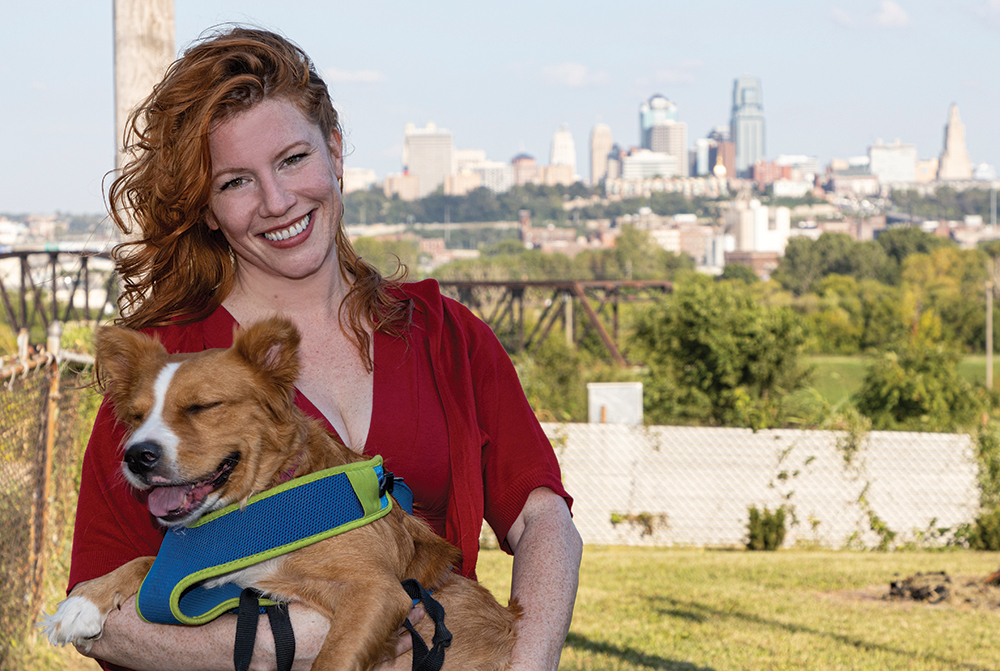
Anna Cole
Strawberry Hill, Kansas City, Kan.
When Anna Cole first heard about Strawberry Hill, a Kansas City, Kan. neighborhood that’s perched on the bluffs overlooking the Kansas and Missouri rivers, she thought it was too good to be true. Now, more than a decade later, she’s transitioned from renter to homeowner (in the same house) and may soon add another title in addition to owner of West Bottoms event space the Mulberry Room—Strawberry Hill Neighborhood Association board member (elections are approaching). From the comfort of her beloved home, Anna shares the two biggest misconceptions about Strawberry Hill, how she’s seen the neighborhood evolve and why you’re more likely to find Anna in her backyard than anywhere else.
What first brought you to Strawberry Hill?
I lived in Midtown and wanted a change. I did a search on Craigslist for cat-friendly houses, and two houses popped up in Strawberry Hill. I couldn’t believe the pictures versus the rent—I thought it was a scam!
I went to Felitza’s [now closed] for dinner, walked around and found the home that I now own. The rent was so inexpensive, the home had a view of the city and the neighbors were so friendly. I couldn’t believe it. What is this secret? It’s so close to everything and I can have an actual house for $650 a month? I fell in love with the brick sidewalks and the neighborliness of the area. And the aesthetic—you’re in Kansas City, but it almost feels like you’re on the East Coast. It’s no longer a secret, which is cool, but Strawberry Hill still feels like a little hamlet.
How has Strawberry Hill changed since you moved there?
There’s definitely been an influx of younger people opening businesses here, and it’s encouraging to see the UG [Unified Government of Wyandotte County/Kansas City, KS] working with them to facilitate that. The home values—they’re insane! They’ve risen exponentially in the last five years, due to the market, Strawberry Hill’s proximity to downtown KC, and the fact that the secret’s out. There’s also more private investment—you have young people who are coming over, buying a house and able to fix it up. When I moved in, half of the houses on the block were abandoned. Now, they’re all redone. It’s definitely a different vibe—people out jogging, pushing strollers. It’s become a real destination.
I do feel like there should be an effort made to not price out or exclude folks who have been here for a long time. The rent rates have doubled in the last three years. I think it’s important that growth is organic; it’s not big corporations coming in. The growth should be metered by the input of the neighborhood, including homeowners and longtime renters.
What are a few of your favorite neighborhood hangouts?
I love the 403 Club and the Colonial Club, especially the back patio. I recently tried Sarah’s on the Hill, a new restaurant, and I love it. Also Breit’s and, even though it’s not technically on the Hill, I love Johnny’s on 7th.
Describe some of the misconceptions that people have about Strawberry Hill.
That we’re far away! You can get to downtown Kansas City twice as fast from Strawberry Hill as you can from Brookside or Waldo. It’s a four-minute drive, or a $6 Uber ride. Another misconception is crime. We don’t have much at all. I know all of my neighbors, and we’re a neighborhood that works together with both a healthy neighborhood association and neighborhood watch.
In addition to the neighborhood hangouts you mentioned, where do you like to spend time on a day off?
I go to The Ship often. I’m a musician, so live music is what gets me out of the house. I’ll walk the Riverfront Heritage Trail from Strawberry Hill to the West Bottoms. I also spend a lot of time in my backyard, working on my yard and enjoying the view. That’s what’s cool about Strawberry Hill—I don’t need to leave!
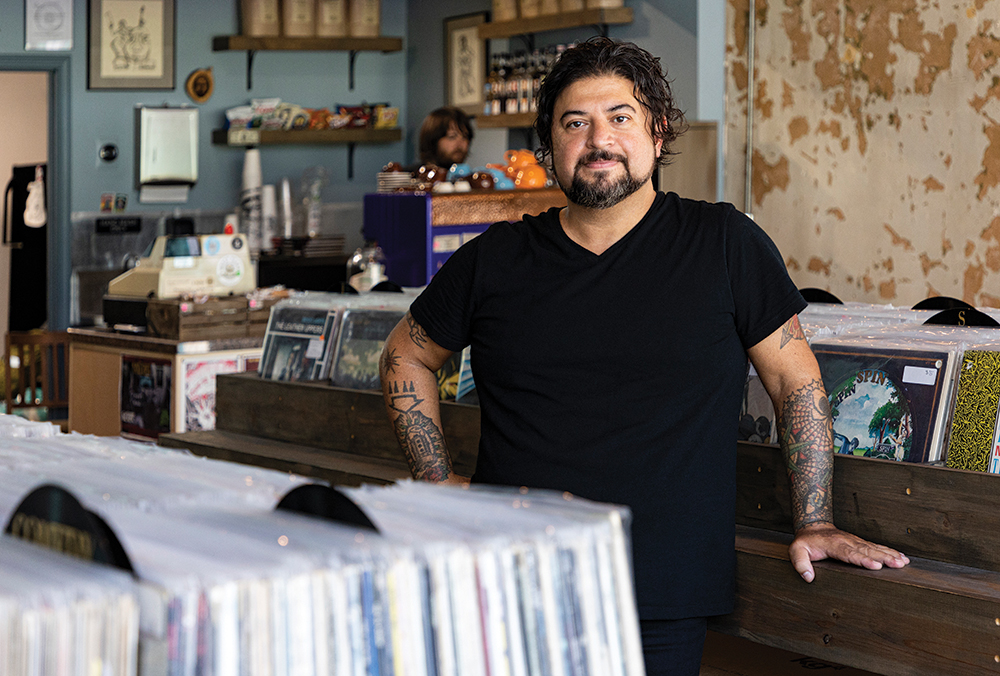
Billy Smith
Longfellow, Kansas City, Mo.
If you’re into Kansas City’s punk rock underground scene or you regularly listen to 89.3 KCUR-FM, you might already know Billy Smith. He started playing in local bands while he was a teenager and worked at several local record stores. As for KCUR, Gina Kaufmann did a 2015 story on Billy after he discovered a reel-to-reel tape recorder and a pile of tapes at a thrift store. While listening to the tapes, he realized they held recordings of a family celebrating Christmas. He eventually found the family featured in the tapes—the Alpough family—and sent them the recordings. KCUR re-airs the story annually as a holiday tradition.
Billy recently pulled up a chair at one of his favorite watering holes, Ollie’s Local, to share more about life in the Longfellow neighborhood (which spans from 25th to 31st Streets and Troost Avenue to Gillham Road/McGee Trafficway) and how it already feels like home, despite only moving there in February. As a VIP manager for Warner Music Group and travel concierge for WWE, Billy travels extensively—sometimes as much as two to three weeks per month. Yet wherever he goes, Kansas City—and, more specifically, Longfellow—is home.
What attracted you to Longfellow?
My girlfriend, Melanie, bought a house here in February after she relocated to Kansas City from New Orleans. We met there during WrestleMania 35. It’s a 120-year-old house that’s been well taken care of—the former owner was a contractor.
Now that you’ve lived there for several months, what do you love about the neighborhood?
We have a great mix of neighbors. The former owners of You Say Tomato live across from us. A lot of people that I know in the area are from the music scene in Westport.
Can we detour down memory lane and hear more about that formative part of your life?
I’ve always loved music and started playing in bands when I was 13 or 14. I worked at The Hurricane (now The Riot Room) and Recycled Sounds record store at the corner of Westport and Main. At the time, Recycled Sounds was an epicenter of culture and information. People from the suburbs would come in to get info on where to hang out. The owner, Anne Winter, was held in high regard both in the record store and in the larger Westport community.
Back to Longfellow! You’ve only been there a short while, but have you noticed any changes in the neighborhood?
I see Longfellow growing before my eyes—it’s the nucleus of what Westport was that’s shattered into this beautiful thing that’s spreading across Kansas City. The stigma of Troost, which seems to be a divider for so many things in Kansas City, including race and income, is fading, and I think my neighbors are welcoming the new businesses. The old Wonder Bread building is being converted into loft spaces. Ruby Jean’s has been an anchor—I love their smoothies. Plus, you have longtime places like Succotash. It seems like the newer businesses are locally owned, which I always strive to spend money on.
What are a few of your favorite neighborhood hangouts?
Sister Anne’s is part record store, part coffee shop, named for Anne Winter, the owner of Recycled Sounds. Jim Oshel [who co-owns Sister Anne’s with Frank Alvarez] is a 10-year barista from Broadway Coffee and the coffee they serve at Sister Anne’s is a roast he created. He’s a superstar, award-winning barista who’s serving you coffee while you buy Motley Crue records.
I love Blip Roasters because I can get coffee or locally made Balance shots. Brunch at Ollie’s Local is underrated, and Kitty’s Café is a main staple. Everyone talks about the pork tenderloin, but I love their burger. If you know about it, you know!
If you’ve been on the road for awhile, what are a few of the places you have to stop once you’re back in KC?
I always crave Voltaire’s happy hour and Mexican food, especially Ponak’s or Los Tules. Poi-O Chicken is kind of a hidden gem right now. The way they make their chicken is incredible and the sides are where it’s at. Harry’s Bar & Tables is one of my anchors. They make the best slightly dirty Ketel One martini.
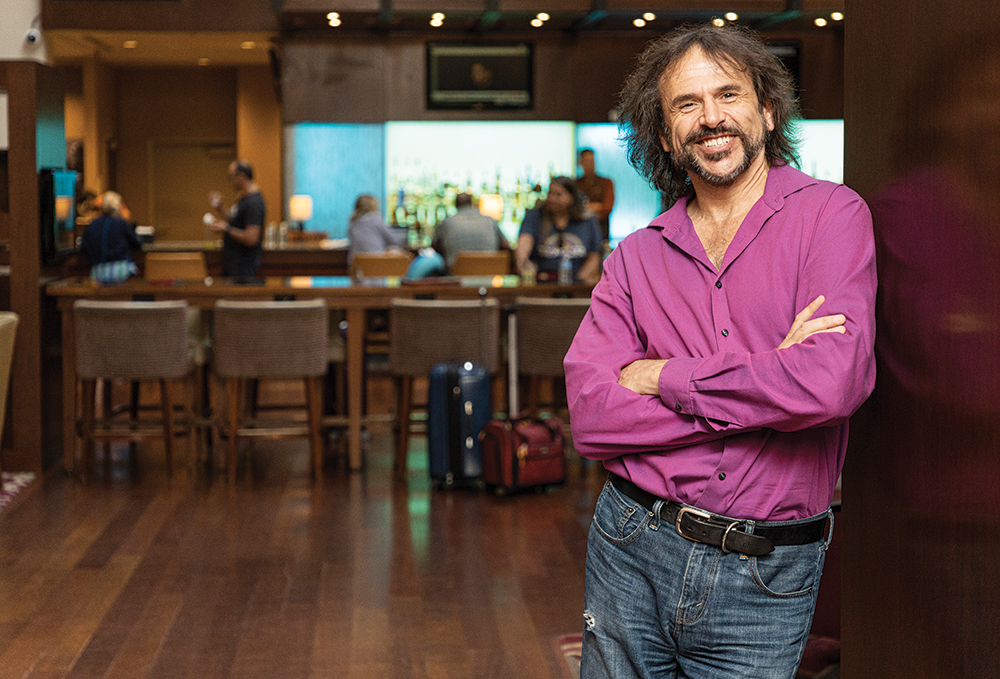
Phil Kinen
Downtown Kansas City
Phil Kinen has had a front-row seat to downtown Kansas City’s revitalization, and there’s no better view for the playwright and theater director. Not only has he lived in the downtown area since 1988; he’s spent all but the last year in the same building. After Phil’s longtime building, Delaware Lofts, sold last year, he packed up his life and started a new chapter in downtown’s nearby Garment District. For this conversation, he returned to his former neighborhood for the first time in months to share what brought him to the downtown area, how he defines downtown’s geography and how his rural upbringing taught him the meaning of community and influenced the River Market’s evolution.
First things first: what do you consider the boundaries of downtown Kansas City?
Truman Road to the south and Interstate 35 to the north. I don’t consider the River Market or the Crossroads part of downtown. They’re separate neighborhoods. Last year, I moved to the Garment District, which is downtown.
What initially brought you to the downtown area?
I grew up on a huge farm in northwest Kansas—8,700 acres. I went to college in Salina, Kan., and grad school in Warrensburg, Mo. When I was done, I moved to Johnson County to be near my teaching job but started coming to the River Market—it was called the River Quay at that time—to spend time with friends. They asked me why I didn’t live in the neighborhood, and I asked myself the same thing. My friend Jeff Church, with the Coterie Theatre, put me in touch with Helen Zarda, who worked for Mel Mallin [a respected developer credited with pioneering downtown Kansas City’s loft market]. A few weeks later, I moved into Delaware Lofts.
When I first started living in the River Market, downtown was like someone had pulled the shades down on the weekend. You could walk down the middle of the street because there was no traffic. When Mayor [Kay] Barnes started working on her downtown revitalization initiative, it was really exciting to be down here. I remember Mel being so excited about what could happen.
How has the River Market changed since you first moved there?
The River Market always had a community feel. Everybody knew everybody—it was like Mayberry. There were a lot of artists, so the neighborhood had a true bohemian feel to it. This was a community that would foster the necessary changes in your life and help you embrace them.
The River Market changed after Market Station was built. It became difficult to get in and out of the neighborhood because of traffic, and the River Market started to feel more transient. The neighborhood charms were now becoming blight; we had to scrub everything up.
One of the best things that happened to us was the Kansas City streetcar. It really saved some people’s lives in terms of helping them get to the services they needed, like the grocery store.
What are a few of your favorite neighborhood hangouts?
I love having cocktail meetings in the lobby of the Marriott. I feel like I’m in a Hitchcock movie and I’m about to have a cocktail with Cary Grant. Caddyshack is also one of my favorite places because it doesn’t give a damn who you are. Everyone is welcome.
When you look back on almost three decades living in Delaware Lofts, what’s one of your most treasured memories?
I was home sick with a cold during the school year—1994, I think. I needed some 7-Up, so I ran downstairs to the pop machine. I looked like crap and was barefoot, even in winter. When I reached the lobby, there was an extremely tall, exquisite-looking woman standing by the machine. It was [dancer and choreographer] Judith Jamison, getting a soda. She was in the building with the Friends of Alvin Ailey, who used to have space in Delaware Lofts. I told her, “Oh my God! I don’t normally look like this!”
What neighborhood business do you miss the most?
Café Al Dente. And I do miss the Old Chelsea Theater for a ton of reasons. I owned the building for a year in 2000 after Mel sold it to me for $1 and I hosted Late Night Theater there.
After unexpectedly leaving your longtime home earlier this year, what have you learned about neighborhoods and community?
People make the neighborhood. I grew up in a farm community and our nearest neighbor was five miles away. Yet there were always things to do—people gathering together and celebrating the positive aspects they could offer. Community is about people wanting to come together, and if they don’t have a reason, they’ll create it. It’s not the physical space; it’s about the tenacity of people, and that’s what got the River Market on its feet.
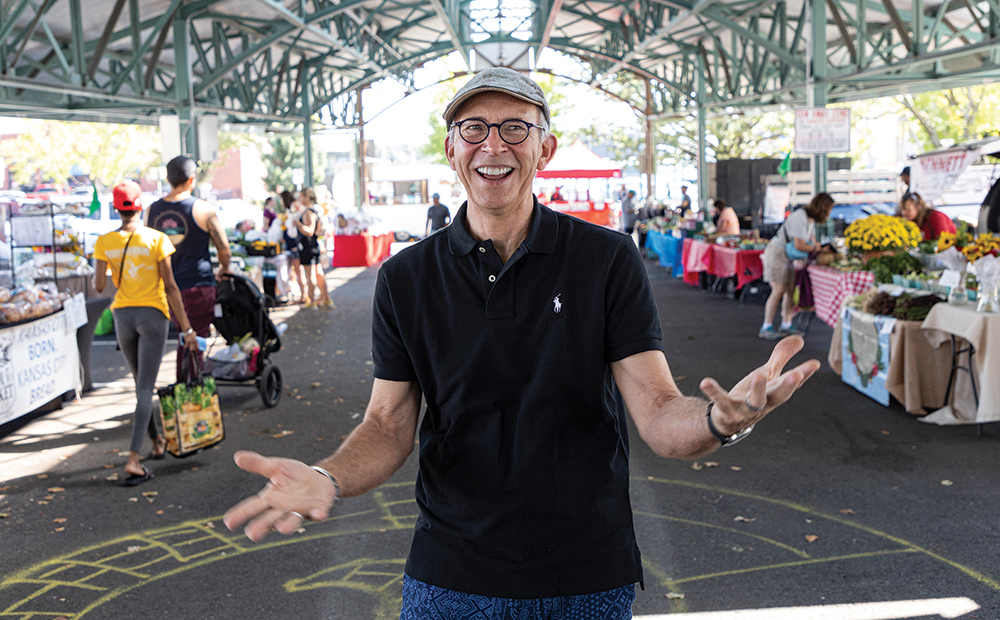
Craig Sole
Downtown Overland Park, Kan.
Leawood, Kan. native Craig Sole didn’t always want to live in Overland Park. In fact, when his brother’s house in old Overland Park went up for sale in 1978, their father had to talk Craig into buying it (“It’s a deal!”), which he did—and, in 1979, moved in. Fast forward to 1991 and, while out on a bike ride, Craig noticed another nearby house in downtown Overland Park and thought it would make a cute space for a shop. He bought the house, made some repairs including a new roof and gutters, and opened his florist business, Craig Sole Designs. While preparing floral arrangements for a big weekend wedding, Craig shared his thoughts on downtown Overland Park’s recent development and his related epiphany, as well as the restaurant that entices him away from his neighborhood of more than 40 years—but just for a meal!
How has downtown Overland Park changed since you arrived in 1979?
The changes are much more recent, but all of the new development is driven by private investment. About four to five years ago, different companies came to City Hall with their intentions to build an apartment complex or something else—it all happened at the same time.
When I reached my 40s, I realized I didn’t want to become an old fart. People get angry about change as they get older, but change is inevitable. I can complain about it, or I can help direct it. I’m on the downtown Overland Park Board of Directors and I help guide how the new development happens. A lot is going on, and I think it’s good. We recently had four different murals installed, and they’re beautiful. They’re all Scribe’s work. He painted a blue gill across the street from me, and on the other side, he painted the meadowlark, the state bird of Kansas. They’re exquisite.
Have you considered living in a neighborhood besides Overland Park?
No! It’s so easy to get around, which is why all of this building happened. You’re dead center to all of the access. I hear horror stories of people who live in Los Angeles and how long it takes to get somewhere. Do you know how lucky we are? What a blessing we have—we just don’t appreciate it.
What are some of your favorite businesses in downtown Overland Park?
Else’s Ethiopian Food—she’s a really special lady. She and her husband have had the restaurant for ten years and they deserve everything good that comes their way. Mi Ranchito, which took over the old John Francis restaurant, has blossomed into several different locations and they’re just marvelous. We also love Dragon Inn, located in the original dry goods store. Downtown Overland Park is a very friendly place.
Any other favorite local spots?
I recently celebrated my birthday at Trezo Mare. We sat on the patio and watched the sunset, which was exquisite. There’s a newer place that’s wonderful—Ni Hao Fresh, which took over the former Freebirds space on Metcalf. Rebecca, the owner, is the daughter of the people who own Dragon Inn. They do made-to-order poké and stir-fry bowls and they have fresh ahi tuna and salmon. They even have orange caviar, all for less than $10. I’ve been there at least ten times!
What are some of the misconceptions about downtown Overland Park?
It’s surrounded by a lot of pre-war and World War II-era housing, which makes some people think there isn’t anywhere to live that’s decent. But you make the house your own. So many people have done marvelous things with their homes. Parking is also considered a big problem, and yet there are plenty of parking lots (I was on that committee). On a busy Saturday, you can find a parking spot within three minutes, 90 percent of the time. You might have to walk 100 feet. People are used to parking in front of a store, and it doesn’t work that way any more.
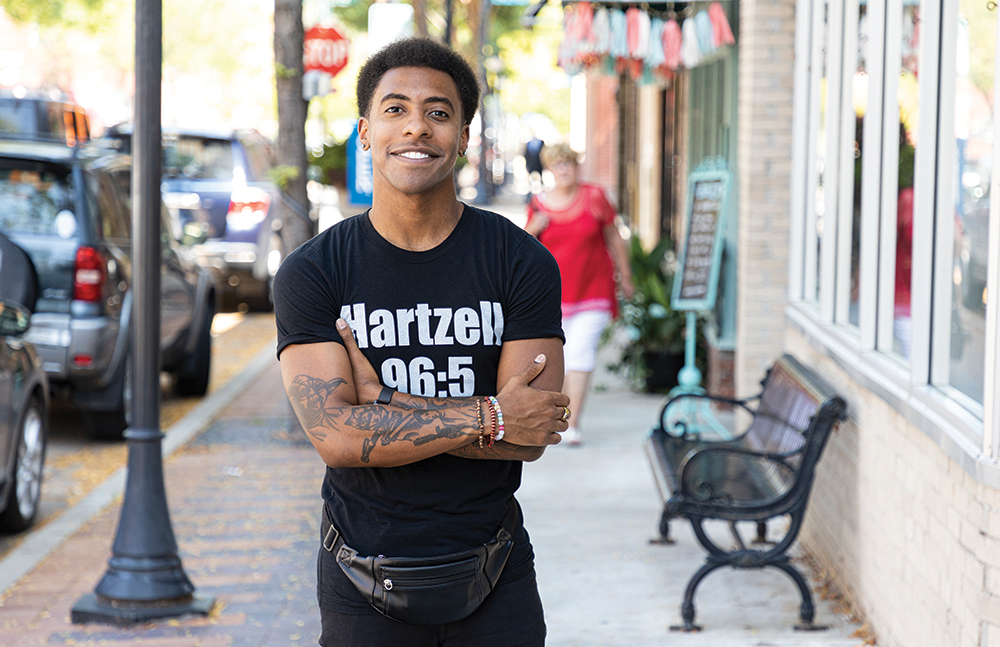
Hartzell Gray
Lee’s Summit, Mo.
Let’s just get this out of the way. Hartzell Gray, on-air personality for 96.5 The Buzz and MC/host for Sporting Kansas City, lives in Lee’s Summit with his mom. After all, it’s important to cut costs wherever possible as a starving artist! Yet Hartzell also credits his living situation with a rare opportunity to experience his neighborhood in three perspectives—as a kid, a college student, and now, an adult. Right after going off the air during his weekday 96.5 The Buzz show, Hartzell After Dark, he switched gears to share more about those perspectives, why moving to Lee’s Summit is the most consequential decision of his life and his answer to the eternal Lee’s Summit debate: The Peanut vs. Stuey McBrew’s.
What took you to Lee’s Summit?
I’m one of three kids to a single mom who busted her ass and moved us to the suburbs, to a neighborhood called Pryor Meadows. She got a great new gig and my twin brother and I had an opportunity to start fresh at a new high school. My mom came through with maybe one of the most important decisions of her life, but in turn, it was one of the most important decisions in my life—definitely the most consequential, all of it for good. I can never stop thanking her for making that call. She went out on a leap of faith and changed our lives.
Can you share more about why moving to Lee’s Summit proved so important in your life?
This community, Lee’s Summit, allowed me the opportunity to figure this thing out. What does it mean to be an adult? Who is Hartzell Gray? I can’t pretend like I have the answers now, but imagine a high schooler that has brand-new surroundings at every turn. Imagine having to tackle that question in a community that didn’t invite you or didn’t feel like you should be there. We lucked out—my family lucked out. One of the reasons I love my community, this Lee’s Summit adopted community so much, is because we had our perspectives and realities and experiences before we got here, then we arrived and we were welcomed. I know everything I do after this will have a little bit of Lee’s Summit in it.
How has Pryor Meadows changed since you moved there in 2006?
When we moved there in the spring of 2006, we were one of a few families. Now, we’re some of the earliest people who are still kickin’ it in Pryor Meadows. Shout-out to Mom for making us one of the founding families! Like a lot of people, we expected that boom to go on forever, then the recession hit. We had to sputter for a little bit, but those same empty plots of land where the pool was going to be—well, the pool’s there now. It took a little longer than we thought, but I’d say Pryor Meadows is now thriving.
What makes this neighborhood so special is that we’re infused with so many new voices, so many types of people, and I hope we don’t lose that. This town gave us a hug when we showed up. They collectively showed up at our doorstep with a basket of cookies. I hope Lee’s Summit still has that kind of welcoming committee.
Let’s settle this. The Peanut or Stuey McBrew’s?
I’ve always been Team Stuey’s. If I want to sound professional, I call it Stuart’s. Shout-out to Billy, one of my favorite bartenders who also runs Squints Apparel, which makes some of my T-shirts for the radio show. Isn’t that such a Lee’s Summit story? That answer right there—that’s Lee’s Summit.
How else do you enjoy spending time in Lee’s Summit or Kansas City?
My ideal day is outside on a patio or walking around. I’ve gotten into this whole ‘be a tourist when you’re not a tourist.’ I love to walk around and sightsee, not even take a ton of pictures, just try to soak it in. I’m trying to look up and live and get my face out of my phone.
Any final thoughts about your neighborhood?
Home is where your heart is. In this situation, I’m always going to be a Kansas City kid—I’m a city boy. But I feel like I can say Lee’s Summit is my adopted hometown, and it’s pretty cool to have two hometowns.
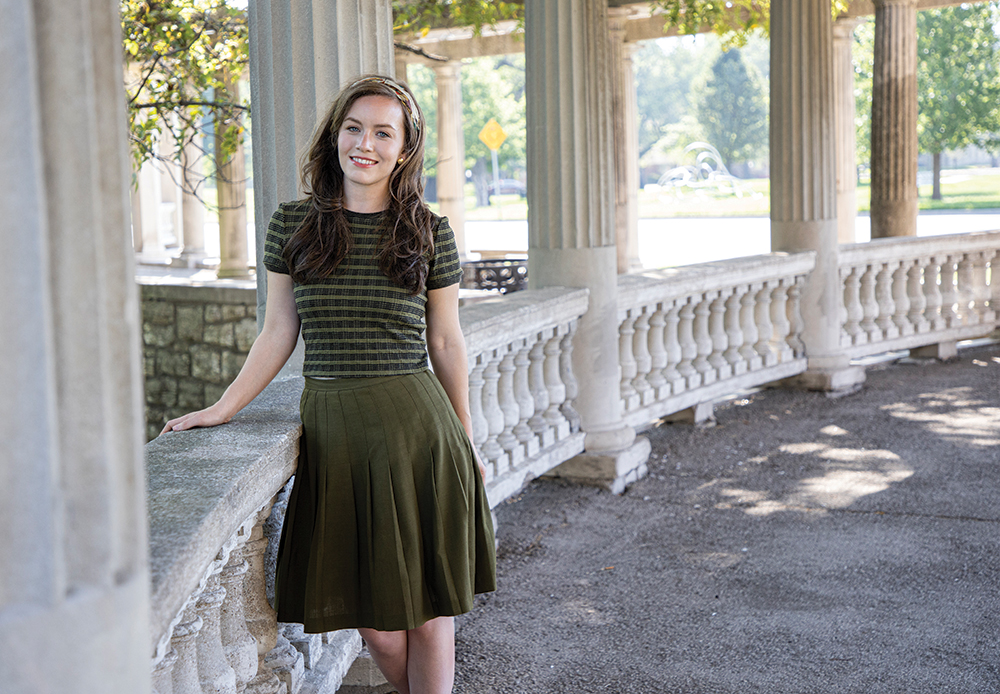
Meg Spilker
Scarritt Renaissance Neighborhood, Kansas City, Mo.
Calling the Scarritt Renaissance neighborhood a hidden gem may be one of the best ways to describe the area of Kansas City that Meg Spilker calls home. She’s no stranger to blank stares when people ask her where she lives. “People usually have no idea where it is or have never even heard of it,” she said. Scarritt Renaissance is about six minutes east of City Market and home to beloved local landmark Cliff Drive (more on that soon). In the midst of prepping for one of the National WWI Museum and Memorial’s biggest weeks of the year (a gala and new exhibit), Meg, the museum’s graphic designer and social media manager, found time to share what she thinks is the best-kept secret in Kansas City, what people get wrong about Scarritt Renaissance, and why her apartment is a prime example of architectural time travel.
What initially attracted you to Scarritt Renaissance?
When I drove through Scarritt a couple of years ago to start looking for a new area to call home, I was shouting exclamations in the privacy of my car over the towering, tree-lined street of Gladstone Boulevard and the century-old mansions. Certainly the architecture and heritage drew me in, but I was excited that such a setting also has ten-plus international markets, an active neighborhood association and preservation efforts, and neighbors that represent over 40 different nationalities. It’s a fascinating place to come home to.
What do you love about living in your neighborhood?
My shotgun apartment was built in 1905 and remains virtually unchanged for a century, still even including a tiny “servant’s room” off of the kitchen and a double mantel fireplace in the main room. Based on what I’ve seen in the neighborhood, this architectural time travel is common to Scarritt.
But to my favorite feature: I have long heard of the mysterious “Cliff Drive” and now I know it is the best-kept secret in Kansas City. The scenic byway path is usually closed off to cars and is a tranquil 4½ miles for walking or biking lined with natural springs, towering trees, wildflowers and ferns. I like to explore, and this feature leaves plenty for that. I can see the skyline of Kansas City from an expansive park but feel as if I’m on a country retreat.
What are a few of your favorite Scarritt hangouts?
Can I say a 50-foot slide? The neighborhood kids (and a few adults!) head to the park in the evenings to plunge down an embankment slide, play in the beautiful new playground, or run through the fountain park. The other night, a kid asked me to play soccer with him. We didn’t know each other’s language but we had a great time playing as neighbors. I’m always meeting someone new there!
My go-to in the mornings is Eleos Coffee. This community-focused coffee shop not only has great coffee and food, but their mission is to actively support community transformation by serving the poor and needy in the community.
Are there any misconceptions about your neighborhood that you want to correct?
Scarritt has been excited about its rebirth. I’m surprised by the wariness of some KC residents to even visit the neighborhood when it is actually a thriving and welcoming place, full of families, students, and creative movers-and-shakers.
How has Scarritt changed since you moved there almost two years ago?
Even just being here for under two years, I’ve felt the mood shift. There’s a strong culture of creativity and uniqueness. We’ve also just had the excitement of the J. Rieger & Co. distillery opening next door and the renovation of Kansas City Museum’s new leading-edge facility opening next year which has everyone asking what might be next for Scarritt.


